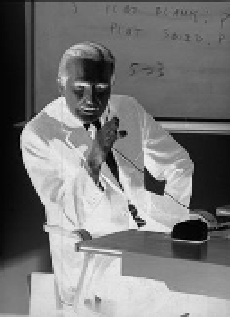Information Technology Reference
In-Depth Information
Three pioneers of interactive computing
Licklider and human-computer symbiosis
Although his name is not well known to the general public, few people have been more influential in
the evolution of computing than J. C. R. Licklider (see
Chapter 10
,
B.10.1
, for a brief biography). Lick, as he
asked everyone to call him, studied psychology as an undergraduate at Washington University in St. Louis
and followed up with a PhD in psychoacoustics at the University of Rochester. After a spell at Harvard, Lick
moved to MIT in 1950. His interest in information technology and human-computer interactions had led
him to become involved with the Semi-Automated Ground Environment (SAGE) air-defense system. The
Cold War threat of an airborne nuclear attack on the United States had triggered the development of SAGE.
The system derived from Jay Forrester's original Whirlwind project at MIT. Forrester's team built a proto-
type for the SAGE system, and IBM, the lead contractor for the project, produced the system for installation.
Each SAGE computer could track up to four hundred airplanes and support up to fifty terminals. From
his experience with this project, Lick had become convinced of the value of computers to analyze data in
real time, as the data came in, instead of being confined to the traditional batch processing of mainframe
computers. Lick summarized his ideas in an influential paper called
“
Man-Computer Symbiosis,” published
in 1960, arguing for the need to develop computers that could interact with humans to support real-time
decisions - that is, decisions that need to be made at the actual time that events were happening. In 1962,
Lick was given a unique opportunity to implement his vision for the future of computing. He was invited
to lead a new research program at the U.S. Department of Defense's Advanced Research Projects Agency
(ARPA). Lick was based in the Pentagon and had, as Michael Hiltzik says, “one 'cloak-and-dagger' project
under his nominal jurisdiction [that was] so highly classified even he was not cleared to know what it was.”
28
Licklider's Information Processing Techniques Office (IPTO) ultimately had a larger computing research bud-
get than all of the other U.S. government agencies combined. Lick's strategy was to place his trust in a
small number of talented individuals and outstanding centers of academic excellence. Lick nurtured inter-
active computing research not only at MIT but also at the University of California in Berkeley, Carnegie
Mellon University, Stanford University, and the University of Utah. He
gave researchers significant amounts of funding that enabled them to
pursue long-term research goals without too much interference or fre-
quent proposal writing. His program of interactive computing ultimately
delivered major advances in many important areas, including network-
ing, computer graphics, software engineering, and human-computer
interactions. A major component of his program was a $3 million grant
to MIT for Project MAC (Project on Mathematics and Computation), a pio-
neering time-sharing system that eventually could support up to thirty
users at any one time. Lick's ARPA centers at Utah and Stanford gener-
ated almost all of the ideas embodied in today's computer user interfaces.
David Evans and Ivan Sutherland headed the graphics research group of
at the University of Utah, and Doug Engelbart (see
B.8.12
) led the Human
Factors Research Center at the Stanford Research Institute.
One of Lick's most significant contributions while at ARPA was his
role in helping establish computer science as a valid research discipline in
universities. Bob Taylor, one of his successors at ARPA, said:
B.8.12. Doug Engelbart (1925-2013)
was best known as the inventor of the
mouse. In fact Engelbart played a lead-
ing role in many major developments
in computing. This photo shows him
rehearsing for the demo in 1968, which
has entered computing history as the
“Mother of All Demos.”
Prior to his [Lick's] work at ARPA, no U.S. university granted a Ph.D. in
computer science. A university graduate program requires a research
base, and that in turn requires a long-term commitment of dollars. Lick's


Search WWH ::

Custom Search